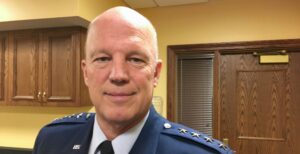 WASHINGTON: Air Force Secretary Barbara Barrett says the new Space Force will be “rolled out” in tranches over the next 18 months — a schedule that other senior service officials say is faster than originally planned.
WASHINGTON: Air Force Secretary Barbara Barrett says the new Space Force will be “rolled out” in tranches over the next 18 months — a schedule that other senior service officials say is faster than originally planned.
The devil is in the details, however, with many insiders seeing signs the service is looking for ways to stretch out the Space Force stand-up. In particular, Air Force plans for implementing Congress’s mandate for a new acquisition executive for space have yet to take shape — with the service having fought fiercely against the concept during congressional debate about the 2020 space policy bill.
As of President Donald’s Trump’s signing of the 2020 National Defense Authorization Act (NDAA) tonight at Andrews Air Force base, 16,000 personnel from Air Force Space Command (AFSPC) were “reassigned” to the Space Force, Barrett told reporters today at her first official press briefing.
“There has been a planning team that has been been building the phased construction of this force and the development of this force, so that we have a plan on the 30- 60- and 90-day and 120-day program that will incorporate additional staff into that force,” she explained.
Some 200 personnel will be assigned to the Space Force headquarters at the Pentagon to plan those incremental moves.
She added that the roll out will “be under the leadership of Gen. Raymond, because of the leadership of US Space Command today.” Gen. Jay Raymond, as envisioned by the NDAA, was tapped by Trump to serve as the Chief of Space Operations (CSO) for the first year. Until tonight, Raymond served as commander of AFSPC and Space Command, stood up in August. Trump’s signature means AFSPC is officially redesigned as Space Force.
“With my signature today, you will witness the birth of the Space Force and that will be now officially the sixth branch of United States Armed Forces,” Trump said at tonight’s signing ceremony. “That’s a big moment,” he added.
In a briefing for reporters, senior Air Force officials forcefully pushed back against the widespread impression among outside experts that the service is “slow rolling” Space Force implementation — in part to hedge against a change in administration after next year’s elections but in part because there are elements of the congressional strings attached in the NDAA that the service has problems with.
“Remember that the plan we developed said … first of all we’re going to take 60 to 90 days to stand up the initial staff, then finish planning,” explained one senior Air Force officer. “One year after the date of enactment of the NDAA, we were going to bring the first units in.” But, now, he said, the service is bringing that initial trance of units into the Space Force on “day one.”

Gen. Jay Raymond, Commander, now will serve as Chief Space Officer heading up the new Space Force as well as commanding Space Command
“So, that’s not slow rolling,” he said, adding that the Air Force is already “looking at and seeing what we can and should accelerate” from the initial, year-long stand up plan.
Another senior officer stressed that the initial plan would have taken 90 days simply to fill out the new CSO office — a timeline he called “pretty sporty.” Now, however, the service will begin hiring folks for that office “starting on Monday,” he said.
All that said, the first 16,000 active duty and civilian personnel being “re-assigned” to the Space Force officially will remain Air Force personnel (i.e. airmen) — just as if they were assigned to work for the National Reconnaissance Office or a combatant command like Space or European Commands. They will not initially be “spacemen” or whatever moniker is decided to designate Space Force personnel as belonging to a separate service (think soldier for Army, sailors for Navy, etc.)
This means, as several insiders pointed out to me today, that those personnel could be re-assigned back to the Air Force at any time.
The Air Force officials explained that it will take time to figure out the proper procedures to officially transfer airmen to the new Space Force, under current regulations for shifting personnel from service to service. DoD will need to figure out how to fit the process to the current rules for transferring personnel from one service to another.
“The folks who work in a skill set that is exclusively in the domain of the Space Force — officer and enlisted space operators — those folks over time, the next couple months, would go through a process by which we would transfer them, just like we do today when you transfer somebody from the Army to the Navy or the Navy to the Air Force,” one senior Air Force official explained. “You transfer from being in the Air Force to being in the United States Space Force. Our vision for that is that it would be a deliberate process that goes through in a voluntary manner that allows the individual airman to have a choice as to where they go,” he added.
On the other hand, support personnel — security forces, doctors, dentists — currently serving in AFSPC likely will remain with the Air Force, as the service sees those support functions for the Space Force largely being provided by the Air Force, the officials said.
Further, the Pentagon has yet to figure out how it intends to deal with the NDAA-imposed creation of an Assistant Secretary of the Air Force for Space Acquisition and Integration position. The new assistant secretary will oversee the Space and Missile Systems Center (SMC), the Space Rapid Capabilities Office (SpRCO), and the nascent Space Development Agency (SDA). This position eventually will morph into the Service Acquisition Executive for the Department of the Air Force for Space Systems and Programs, explains a new analysis by the Center for Strategic and International Studies (CSIS).
While CSIS and many others have read the NDAA as ordering the transition of the SDA out from under the Undersecretary of Defense for Research and Engineering (USD R&D) and into the Space Force by 2022, the Pentagon says that isn’t quite right.
“It doesn’t say that the SDA would fall underneath the Space Force or the Department of the Air Force,” one Air Force official said. “What it says is that the Assistant Secretary of the Air Force for Acquisition and Integration would direct and oversee the Space Development Agency, the Space and Missile Center and the Space RCO. So it doesn’t necessarily portend an organizational change. It talks about a relationship change.”
He added: “Those discussions will be ongoing.”
Finally, senior Air Force officials said they are already looking at things they might want to change or add next year. For example, DoD will seek congressional approval to be able to add Army and Navy personnel into the Space Force, one official said. That will be the real mark of a single space service.
Air Force picks Anduril, General Atomics for next round of CCA work
The two vendors emerged successful from an original pool of five and are expected to carry their drone designs through a prototyping phase that will build and test aircraft.


























